Hacking the CD Player
This text was originally written in September 2009 and updated for publication in eContact! in 2019.
As a young composer who’d spent the 1970s developing systems for live electronic performance, I could not help being impressed by the first hip-hop DJs I heard. Their transformation of the turntable from an appliance into a musical instrument seemed to encapsulate the artistic zeitgeist of New York City in the early 1980s: here was an inexpensive tool for expressing one’s musical identity — as encoded in a record collection — directly, without the mediation of a traditional instrument. No more learning riffs off records when you could play the record instead — post-Modern Music for the Millions. Yet, despite its apparent simplicity and gentle learning curve, the turntable fostered true virtuosity — watching cutting battles at the Roxy made it clear that the DJs of the 1980s were very different from the radio station personalities previously associated with the acronym.
I was smitten, but my back protested at the mere thought of adding two turntables and a crate of records to my already ridiculously heavy suitcase of electronics. I channelled my craving into performing with DJs (most notably Christian Marclay) and developing lighter-weight techniques for emulating my favourite aspects of DJ craft. I built and programmed an automated mixer that cross-faded channels on rhythmic coincidences, mimicking turntable cutting. 1[1. Can be heard in Is She/He Really Going Out With Him/Her/Them (1982), on Going Out With Slow Smoke (Lovely Music LP, 1982). For more a detailed description of the mixer system, see Nicolas Collins, “Before Apple There Was Kim: The microcomputer, music and me” (2009) on the author’s website.] In my 1985 composition Devil’s Music I used inexpensive early sampling pedals to loop, mix and re-trigger fragments of live radio broadcasts — essentially DJing with radio. 2[2. Nicolas Collins, Devil’s Music (Trace Elements Records LP, 1986; reissued by EM Records in LP and CD format [with additional material], 2009). For a more detailed description of the work and its technology see “Some Notes on the History of ‘Devil’s Music’” (2009) on the author’s website.] However, the original circuits of the samplers were tampered with for my needs in the performance of the work:
In “Devil’s Music” snippets of live radio broadcasts are digitally sampled, looped, retriggered, reversed, and detuned. All the material is taken from FM, AM, and Shortwave transmissions occurring at the time of the performance. The equipment includes a radio, a small mixer, an ElectroHarmonix 16-Second Delay, and one or two ElectroHarmonix Super Replays — inexpensive samplers that I have modified for this piece. The most significant change is the incorporation of “stuttering circuits” that retrigger and reverse the samples in response to the dynamics of the material coming off the air, thus defeating the annoying periodicity of digital delay loops and samplers. As the solo performer, I work with and against this quirky rhythm, influencing certain aspects of it without ever being in full control. I hunt through the radio bands for new material, listening to the performance with one ear while cueing the radio through a headphone on the other, searching for the right shard to drop in at the right time. I cut channels in and out of the mix, shift the balance, slur the tunings, overlay samples, and play with the few other variables that make up the limited range of this “instrument.” (Collins 1987)
In 1986 I began designing my “trombone-propelled electronics,” a live-sampling system that performed instantaneous DJ-style signal transformations on any sound material. This homemade system was built around a modified digital reverb:
I embedded the motherboard from a Commodore 64 personal computer inside the Stargate’s rack-mount chassis, pulled various key chips from the reverb, and connected the computer’s parallel ports to the empty sockets. By hooking up a keyboard, monitor and disc drive I could program the Commodore to emulate the correct behavior of these chips (i.e. simulate reverberation) or perform my own weird variations (live sampling, looping, raspy time stretch). This was a hybrid hardware / software antecedent of hacking the program code in a later generation of DSP-based processors, or writing your own patch in Max/MSP, and I produced unusual signal transformations as a result of the intersection of the two machines. (Collins 2009)
The crook of a trombone 3[3. Purchased years earlier for $12 at a church sale in Ohio.] was mounted with a rotary shaft, its movement coupled to that of the slide using a retractable dog leash such that it functioned something like “a REALLY BIG slide pot” (Collins 2009). The output of the Stargate was sent through the bore of the trombone via a speaker coupled to the mouthpiece of the instrument. A small keypad was mounted on the slide where the right-hand fingers could access it while playing (Video 1). Through the manipulations of the instrument (the left hand operating the slide, the right pressing keys), it became possible to “change any parameter of my program as easily as clicking and dragging icons on a computer screen — the slide became my mouse” (Ibid.).
With the introduction of portable CD players in the second half of the 1980s, spinning discs finally came in under my weight limit. Yasunao Tone was the first composer I heard making use of CDs — for his Solo for Wounded CD (1985) he selectively damaged the discs with strips of Scotch tape, unleashing a torrent of glitches that resulted from overloading the digital error correction system. 4[4. The work is meant to be performed live, but one studio recording of a performance by the composer was released: Yasunao Tone, Solo for Wounded CD (Tzadik CD, 1997). Also see Julien Herion, “Yasunao Tone’s ‘Solo for Wounded CD’ and the Aesthetics of Failure” (2014).] Once loaded into the player, the CD basically played itself, jumping from one location to another in response to the patterns of damage to its surface; Tone used the >>| and |<< controls to nudge the player in one direction or the other, but the system had a mind of its own, and the composer’s control was indirect at best. I loved the sound — the odd juxtaposition of ultra-hi-fi recordings with the harsh digital errors — but I wanted to control the player more directly, ideally approximating turntable techniques such as scratching and cueing. So I bought a portable Sony Discman (model D2) in 1989 and began to experiment.
Un-Mute
With the removal of a single internal connection, the player now produced its own automatic variations on any CD.
I was curious as to what was going on inside a player when the CD was paused, or moving from one track to another. I reasoned that the laser did not lift up from the surface like a turntable’s tonearm, but that some internal circuit simply silenced the audio output during certain “unmusical” operations. I finagled a service manual out of Sony’s US service division, and found (buried in the impossibly complex schematic) a signal pointedly labelled “mute”. I tracked the flow of the signal upstream to its point of origin, a pin on a large chip devoted to controlling the overall behaviour of the player. With a soldering iron and a needle I disconnected the pin from the trace on the circuit board (Fig. 1), which released a flood of hitherto unheard sounds: starting and stopping the disc was accompanied by a brief, loud squawk; pressing “next track” (>>|), especially in “shuffle” mode, evoked a needle being dragged violently across an LP, or John Zorn’s furious stylistic jump-cutting 5[5. I am thinking in particular of his work with his group Naked City, formed around the same time as my earliest CD experiments, and some of the sections of Cobra (1984), a composition in which I had recently performed.]; “pause”, by contrast, isolated short fragments of material from the CD in lilting loops.
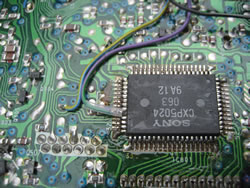
Unlike the familiar metronomic repetition of skipping vinyl, the paused CD “swings”, interrupting its default quarter-note pattern with occasional eighth-note accents that impart a distinctly “musical” feel to the resulting rhythm. By occasionally pressing the “search” (>>) button, or un-pausing the CD for a moment before returning to pause, I could make the player slowly progress through the disc, drawing out the sound material in a stepwise sequence of off-kilter loops. In several earlier compositions I had gone to great lengths to defeat the periodicity of looped samples (for Devil’s Music, for example, I had added “stuttering circuits” to the samplers to disrupt their repetition with quasi-stochastic re-triggering). With the removal of a single internal connection, the player now produced its own automatic variations on any CD.
After listening to every disc in my admittedly modest collection (remember that this was still the early days in the transition from LPs to CDs, and the latter were discouragingly expensive), I found myself drawn in particular to the effect of this process on Baroque and Early Music: the pause loop froze the flow of the counterpoint into modal chords reminiscent of certain styles of 1960s jazz; the glitches that the error correction occasionally threw onto the loops’ seams contrasted beautifully with the lush sound of the period instruments, adding floating rhythmic accents that I dubbed “digital claves”. The overall feeling reminded me vaguely of Terry Riley’s In C, updated for the digital era. 6[6. I acknowledged this debt in my composition In CD (1992), written for the all-Discman band, Impossible Music.]
Broken Light
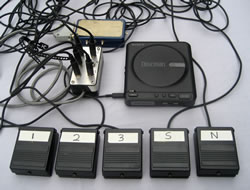
Endearing in its own right, the skipping CD mixed beautifully with live instruments, especially when they were similar to those in the recording. I discovered this in the course of composing Broken Light (1991), which pits a live string quartet against a disc of Baroque concerti grossi by Corelli, Torelli and Locatelli. 7[7. Released on Nicolas Collins, It Was a Dark and Stormy Night (Trace Elements CD, 1992).] The musicians use foot switches to control the CD player: scratching across the disc to trigger noisy rips, calling up specific tracks for each of the three movements and periodically nudging the paused disc ahead through a series of looped phrases (Fig. 2). These loops provide a rhythmic and harmonic underpinning for variations the quartet improvises according to guidelines specific to each movement (Fig. 3). At times it becomes difficult to distinguish the live strings from the recorded ones.
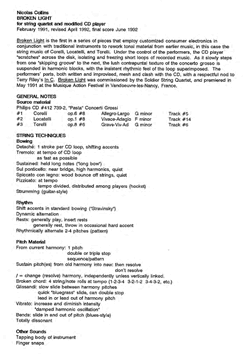
The manipulation of a CD in performance offered me a practical compromise between a backing tape (technically simple, but always the same) and truly interactive computer music (more flexible, but challenging to produce on stage without the composer’s presence): the performers know the tonal content of each track, but can never be sure exactly which fragment of the recording will emerge with each press of the “nudge” foot switch. As a result, performances have the tension and sense of uncertainty associated with improvised music but are set against the harmonic roadmap of a more “composed” form.
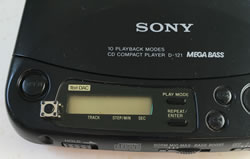
As I tinkered with various players, I discovered some unexpected idiosyncrasies. The first tracks on a CD skip at a faster rate than later ones, so the track numbers are effectively related to and define the tempo of a performance (useful for creating faster and slower sections in a multi-movement piece). The skip rate, tempo irregularities, degree of swing and amount of glitchiness all vary considerably from player to player. Searching for the mute signal in one player, I tapped a test probe to a pin on a chip and was rewarded by the CD slowing to half-speed, and all the sounds dropping an octave in pitch — a feature seemingly exclusive to this one model, a Sony D121 (Fig. 4). I designed most of my pieces using portable Sony CD players around the behaviour of specific models, and substitutions oftentimes significantly changed the character of a work. Unfortunately, with each “improvement” that Sony introduced to their product line (especially in the areas of error correction and “shock” protection), the glitch artifacts grew milder and the general trend toward integration of more functions on fewer discrete ICs made it increasingly difficult to defeat the mute function (Fig. 5). Accordingly, as time went by I was driven to seek out obsolete models, and my instruments became more anachronistic, where once they had seemed so modern.

I joined the all-Discman band, Impossible Music, formed in New York by David Weinstein and Tim Spelios in 1990. The group’s repertoire included various improvised jams with sound effect discs, a live recreation of Revolution No. 9 from the Beatles’ White Album, and In CD (1992), my homage to Terry Riley. This latter piece featured three performers stepping through identical discs of Beethoven’s Piano Trio in D major, Op. 70 No. 1 “Ghost”, evoking Riley’s landmark composition In C as the loops slip out of phase and sync with one another. I built interfaces for controlling a CD player from a computer, which made it possible for me to manipulate discs from my trombone-propelled electronics.
But most significantly I created a number of compositions based on the technique of pairing manipulated CD playback with live acoustic instruments that I first used in Broken Light. In Still Lives (1992) 8[8. On Nicolas Collins, Sound Without Picture (Periplum CD, 1999).], a single trumpet anticipates and suspends pitch material from a canzone by Giuseppe Guami over the looping disc. For Shotgun (1995), I transformed a tiny speaker into a substitute end-cork for Lesley Olson’s bass flute and connected it to a hacked boom box skipping through a CD of shakuhachi music. Oslon’s flute notes mix acoustically with the CD sounds inside the bore of the instrument, producing unusual beating patterns and cross modulations. This piece combined the techniques of the hacked CD player with the acoustic properties of my trombone-propelled electronics (described above), in which a speaker attached to a trombone mouthpiece transformed the brass instrument into a malleable loudspeaker (see Collins 1991 and Collins 2009).
In Die Schatten (1996), two modified Discmen draw out a few measures of Schubert’s Eine kleine Trauermusik, accompanied by 18 musicians. I prepared a pair of source CD-Rs, each with the same recording repeated 22 times to fill the whole disc: one CD player steps through the version in track 1, while the other uses track 22, so that the two discs loop at different tempos, creating a rich, shifting polyrhythm against which the ensemble plays (Video 2). In Broken Choir (1997) 9[9. Written for Berlin’s Zeitkratzer ensemble. On Zeitkratzer, SonX (Zeitkratzer Records, 1999).], CDs of two different 16th-century Venetian canzoni loop at different tempos, producing a texture that is both polyrhythmic and polytonal. English Music (2002) 10[10. Composed for Kammerensemble Neue Musik Berlin. The score and backing track are available in the “scores” section of the author’s website.] uses two tracks of Elizabethan consort music in a similar way. Still (After) Lives (1997) 11[11. Composed for Kammerensemble Neue Musik Berlin. On Nicolas Collins, Sound Without Picture (Periplum CD, 1999). The score is available on the author’s website.] is essentially a re-orchestration of the earlier Still Lives, with a chamber ensemble imitating all the CD artifacts — from looping to glitching — purely acoustically. 12[12. As a composer I have periodically attempted to derive forms for acoustic instruments from other technologically driven pieces.]
Glitch
In the mid-1990s I became aware of the German electronica group Oval, whose recordings made extensive use of CD looping and errors. Here I am thinking in particular of their fourth release in 1994, 94 Diskont (Mille Plateaux CD, 1995). 13[13. A meeting with band member Markus Popp in Berlin led to me producing a remix of a track on Reprovisers, a CD by Microstoria, another group of his (Mille Plateaux / Thrill Jockey, 1997).] Their work was at the vanguard of an emerging movement of “glitch music” that was introducing pop audiences to sounds previously associated almost exclusively with the avant-garde. 14[14. For a good overview of the glitch scene see the Clicks & Cuts CD series on Mille Plateaux, released between 2001 and 2004. The most radical of the glitch groups, Disc, effectively reproduced Tone’s Music for Wounded CD in their various CD releases in 1998 and 1999.] By 2000, the CD-derived glitch æsthetic had become so widespread as to feature on a Madonna album. 15[15. “Don’t Tell Me” on Music (Warner Music, 2000). The track was co-written and produced by Guy Sigsworth, a British producer known for incorporating techniques from experimental music.]
When I hacked my first Discman in 1988, this was simply the most affordable, portable and efficient way for me to gain access to a large library of recorded music for manipulation in live performance. The glitch artifact that became a defining feature of my subsequent compositions was a welcome but unexpected side effect. By the end of the millennium, CD players designed for DJs incorporated cueing functions that produced very similar effects to my mute-removal hack. More significantly, software such as Max/MSP, SuperCollider and PD, running on laptops with large hard drives, made it easy to loop and step through a seemingly unlimited collection of music files in emulation of my modified CD players (which is exactly what I did when my favourite Discman — long out of production and seemingly impossible to find on eBay — finally stopped working in 2007).
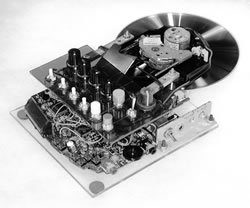
The core sounds of this phase of my compositional life were now well ensconced in the musical mainstream, and my original CD hack had been made redundant by various technological advances. So in 2001 I returned to the ambition that drove me to crack open my first CD player: approximating a DJ’s tactile interaction with vinyl on a turntable platter. I had lost sight of this goal in the exhilaration of discovering the inherent musicality of the pause loops. I opened up an old Discman, flipped over the CD drive mechanism so the laser sled was on top of the disc instead of under it, and removed the motor that drove the laser back and forth. Now the sled moved freely, so I could slide it across the disc with a flick of my finger; this produced an amazing racket as the player’s control mechanism furiously adjusted the laser focus and piled on error correction in a futile attempt to get the disc back on track. Having thoroughly eviscerated the Discman, I now poked around the exposed circuit board with an audio cable in search of other interesting sounds. The data on a CD goes through an impressive series of transformations in the path from microscopic pits on the disc to the final audio output, and one can pick up the signal at almost any point along this route. The circuits that control the motors and coils that spin the disc and guide the laser produce remarkable noises as well, unrelated to the content of the audio tracks. I picked four of my favourite sounds and fed them through playable momentary switches to mix with the CD output. Another switch shuts off the motors completely, which collapses all the audio into a sort of digital black hole. Slapped between two scraps of acrylic plastic, and resembling some kind of power saw, the resulting Sled Dog (Fig. 6) is a paean to the glitch, and a noisily satisfying milestone in my 25-year engagement with the Compact Disc. 16[16. Can be heard in Nicolas Collins, Sled Dog (2001), released on AriaDA 2003 (AriaDA CD, 2003).]
Bibliography
Collins, Nicolas. “Real Landscape: Seven performances of Devil’s Music.” Liner notes to an edited compilation of recordings of seven performances of Devil’s Music from February 1987 (European tour) and April 1987 (New York City). 1987. http://www.nicolascollins.com/devilsmusictracks.htm [Accessed 29 December 2019]
_____. “Low Brass — The Evolution of Trombone-Propelled Electronics.” Leonardo Music Journal 1 (December 1991), pp. 41–44. http://www.nicolascollins.com/texts/lowbrass.pdf [Accessed 29 December 2019]
_____. “The Evolution of ‘Trombone-Propelled Electronics’.” 2009. http://www.nicolascollins.com/texts/TrombonePropelledElectronics.pdf [Accessed 29 December 2019]
Social top